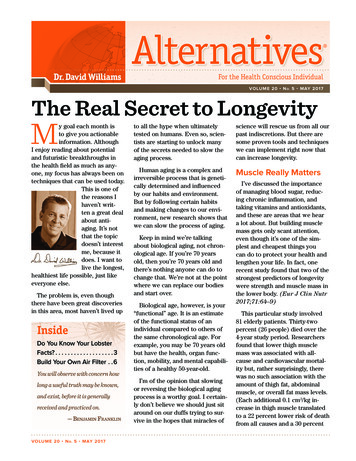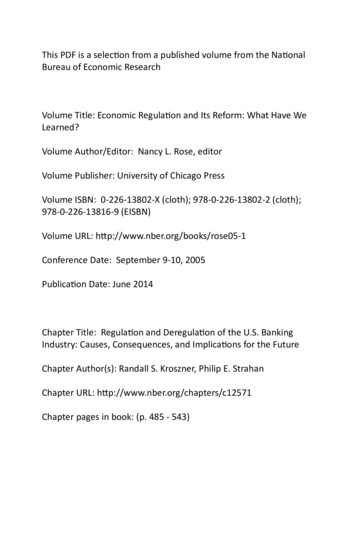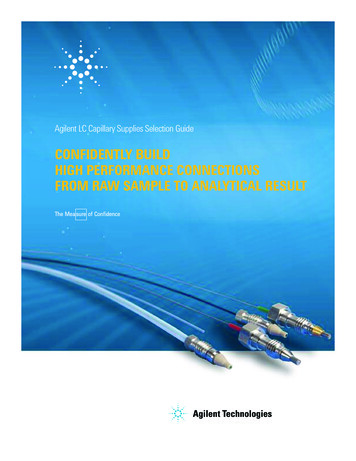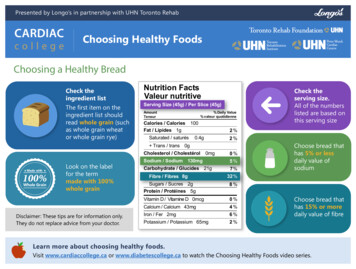
Transcription
VOLUME 20 N O. 5 MAY 2017The Real Secret to LongevityMy goal each month isto give you actionableinformation. AlthoughI enjoy reading about potentialand futuristic breakthroughs inthe health field as much as anyone, my focus has always been ontechniques that can be used today.This is one ofthe reasons Ihaven’t written a great dealabout antiaging. It’s notthat the topicdoesn’t interestme, because itdoes. I want tolive the longest,healthiest life possible, just likeeveryone else.The problem is, even thoughthere have been great discoveriesin this area, most haven’t lived upInsideDo You Know Your LobsterFacts?. . . . . . . . . . . . . . . . . . . 3Build Your Own Air Filter. . 6You will observe with concern howlong a useful truth may be known,and exist, before it is generallyreceived and practiced on.— Benjamin FranklinVOLUME 20 N O. 5 MAY 2017to all the hype when ultimatelytested on humans. Even so, scientists are starting to unlock manyof the secrets needed to slow theaging process.science will rescue us from all ourpast indiscretions. But there aresome proven tools and techniqueswe can implement right now thatcan increase longevity.Human aging is a complex andirreversible process that is genetically determined and influencedby our habits and environment.But by following certain habitsand making changes to our environment, new research shows thatwe can slow the process of aging.Muscle Really MattersKeep in mind we’re talkingabout biological aging, not chronological age. If you’re 70 yearsold, then you’re 70 years old andthere’s nothing anyone can do tochange that. We’re not at the pointwhere we can replace our bodiesand start over.Biological age, however, is your“functional” age. It is an estimateof the functional status of anindividual compared to others ofthe same chronological age. Forexample, you may be 70 years oldbut have the health, organ function, mobility, and mental capabilities of a healthy 50-year-old.I’m of the opinion that slowingor reversing the biological agingprocess is a worthy goal. I certainly don’t believe we should just sitaround on our duffs trying to survive in the hopes that miracles ofI’ve discussed the importanceof managing blood sugar, reducing chronic inflammation, andtaking vitamins and antioxidants,and these are areas that we heara lot about. But building musclemass gets only scant attention,even though it’s one of the simplest and cheapest things youcan do to protect your health andlengthen your life. In fact, onerecent study found that two of thestrongest predictors of longevitywere strength and muscle mass inthe lower body. (Eur J Clin Nutr2017;71:64–9)This particular study involved81 elderly patients. Thirty-twopercent (26 people) died over the4-year study period. Researchersfound that lower thigh musclemass was associated with allcause and cardiovascular mortality but, rather surprisingly, therewas no such association with theamount of thigh fat, abdominalmuscle, or overall fat mass levels.(Each additional 0.1 cm2/kg increase in thigh muscle translatedto a 22 percent lower risk of deathfrom all causes and a 30 percent
Alternativesreduced risk of cardiovasculardisease.)recovering, than it does during theactual workout.Americans. (Med Sci Sports Exerc1999 Jan;31(1):25–30)It might seem implausible thatthe mass and strength of your thighmuscles could have any bearing onwhether you die from conditionslike cardiovascular disease, cancer,or diabetes. But keep mind that themuscles in your thigh region arethe largest and some of the strongest in the body. When you exercise the biggest muscles in yourbody, several things happen.Resistance training has beenshown to increase the amount ofcalories burned by an extra 100 inthe hour after a workout. And sincemuscle cells, unlike fat cells, continually burn calories while at rest,the more lean muscle you build, thehigher your metabolic rate and fatburning capabilities will be.Thanks to the fact that our society is largely sedentary, mobilityand stability issues are no longer aproblem among just the elderly. Ifyou’ve been to the mall or grocerystore, you’ve probably noticed justhow many middle-aged shoppersuse the motorized scooters.When it comes to weight andfat loss, this approach is far betterthan going on a low-calorie diet.A low-calorie diet will allow youto experience temporary weightloss, but at the expense of leanmuscle tissue. In the end, the lossof muscle ends up decreasing yourresting metabolic rate.So how do you beef up yourleg muscles and at the same timeimprove your longevity? Squats!It’s the absolute best exercise forstrengthening the muscles in yourthighs and buttocks and aroundyour hip and knee joints.First, your muscles’ demand forglucose increases, making themmore receptive to insulin. Withbetter insulin sensitivity, you havemore efficient burning of bloodsugar and more food being storedas glycogen in muscles instead ofas fat. Your body also becomesmore efficient in its ability to access and burn fat, particularly thebelly fat associated with diabetesand heart disease. Resistancetraining is an effective method toboth prevent and treat diabetes.Many type 2 diabetes patients curetheir condition with the properdiet and exercise program.Second, exercising these largemuscles immediately increasesyour metabolic rate, resulting inmore calories burned. Bodybuildersand weightlifters often talk about“after burn.” This refers to thebody burning more calories aftera weightlifting session, when it isAlternatives Third, building up your thighmuscles improves levels of otherhormones besides insulin. For instance, testosterone levels stabilizeor rise, and inflammatory cortisollevels fall. (The opposite typicallyhappens when you follow a calorierestricted diet.)Finally, strengthening these muscles can also increase bone densityin the hip and thigh bones.It’s hard to over-stress the importance of maintaining bone densitywhen hip fractures have becomethe number-one reason for nursinghome admissions, and falls remainthe leading cause of death in olderThe Best Exercise to DoIn addition, implementing squatsin your exercise routine willimprove your stability and bonedensity, help you stand up from aseated position, and help you climbstairs better. Even more important,strengthening your thigh muscleswith squats can reduce your risk ofinjury and premature death frompractically all causes.To safely and properly squat (especially if you’re new to the exercise), use a chair as a “safety net.”Stand in front of the chair withyour feet spread shoulder-widthapart. Keep your back straightand your arms extended in frontof you. Slowly and steadily bendyour knees and lower yourself, asAuthor: Dr. David Williams; Editor: Larissa LongISSN# 0893-5025. Published monthly for 69.99/yr. by Mountain Home Publishing at 6710-A Rockledge Dr. Ste. 500, Bethesda, MD 20817.Editorial Office: 6710-A Rockledge Dr. Ste. 500, Bethesda, MD 20817. Periodicals postage paid at Bethesda, MD and at additional mailing offices.Postmaster: Send address changes to Alternatives, PO Box 11, Montoursville, PA 17754. Copyright Healthy Directions, LLC All rightsreserved. Photocopying or reproduction is strictly prohibited without permission from the publisher.The approaches described in this newsletter are not offered as cures, prescriptions, diagnoses, or a means of diagnoses to different conditions.The author and publisher assume no responsibility in the correct or incorrect use of this information, and no attempt should be made to use anyof this information as a form of treatment without the approval and guidance of your doctor.Dr. Williams works with Healthy Directions, LLC to develop his unique formulations that supply many of the hard-to-find nutrients herecommends. Dr. Williams is compensated on the sales of these nutritional supplements and health products, which allows him to continuedevoting his life to worldwide research and the development of innovative, effective health solutions.2MAY 2017
though you are going to sit in thechair, but stop just short of touching the chair. Hold that positionfor a couple of seconds (longeras you progress) and then slowlycome back to a stand. (How closeyou can actually get to the seat ofthe chair will depend on the initialstrength of your thighs.) Do this 10times and work up to three sets.To make it more challenging, usesomething lower than a chair, likea short stool or ottoman.If you have good balance, youcan also strengthen your calvesand ankles by lifting up on the ballsof your feet when you stand andholding that position for a coupleof seconds. If your balance isn’tso good, then do this calf exerciseseparately while holding on to theback of the chair.Telomeres: The Secret toLiving Forever?There are numerous theories onexactly what causes aging, and oneof the most popular has to do withtelomere length. The relationshipbetween aging and telomeres canbe a little confusing, but I’ll do mybest to summarize and explain thehigh points.Telomeres are protective littlecaps at the end of double-strandedmolecules of DNA called chromosomes. They have been compared to the plastic tips on shoelaces. (Just in case you happen tofind yourself on the game showJeopardy, those little plastic tipsare called aglets.) Telomeres protect the ends of chromosomes fromfraying and sticking to each other.Every time a cell divides, thetelomeres get shorter. When theyget too short, the cell can no longerdivide, and it becomes inactiveVOLUME 20 N O. 5Do You Know Your Lobster Facts?While researching the immortality of lobsters, I came across somefascinating facts. Lobsters’ teeth are located in their stomachs. The grinding/chewingstructure is called a gastric mill. Lobsters use chemosensory hairs on their legs and feet to taste food. Lobster blood is clear and an adult lobster’s brain is no larger than thetip of a ballpoint pen. Lobster shells are used to make biodegradable golf balls, designed forgolfing on cruise ships. Lobsters were once considered to be “tasteless” and were so plentifuland inexpensive they were a pauper’s food. In 2009, a Maine fisherman caught a lobster that was estimated to be80–140 years old. Named George, he was kept as a pet in a restauranttank for 14 days. After dozens of pictures with the restaurant’s clientele, he was released back into the wild.and dies. Telomere shortening isa sign of aging and has also beenassociated with oxidative damage,insulin resistance, diabetes, heartattacks, stroke, vascular dementia,obesity, osteoporosis, some formsof cancer, and an overall increasedrisk of death.Telomerase is an enzyme thathelps rebuild and maintain telomere length. This enzyme is activein germ and stem cells when ourbodies are growing, but production shuts down in adults. Manyresearchers believe if we couldcontrol and increase telomerase production, telomeres wouldn’t shorten,cells could continue to divide indefinitely, and we would live forever.The idea isn’t as far-fetchedas some might think since that’sexactly what happens in lobsters.Lobsters (and some flat worms)produce telomerase continuously.So instead of their telomeres shortening with age, they constantlyrejuvenate. Rather than gettingweaker and more vulnerable withage, lobsters become stronger andmore fertile each time they shedtheir shells. Lobsters are unique inthat they don’t die as a result of aging. In that sense, they are biologically immortal. They die becausethey are eaten, injured, poisoned,or exposed to disease. See thebox above for additional factsabout lobsters that you probablynever knew! (FEBS Lett 1998 Nov13;439(1–2)143–6)There’s a caveat, however, whenit comes to influencing telomeraseproduction. Human cancer cellsproduce telomerase, and that’sone of the reasons cancer is sodifficult to fight. Their ability toproduce telomerase makes cancercells close to immortal. So theproblem lies in whether we canincrease the amount of telomerase that can undo and protect ourtelomeres without increasing therisk of cancer. (Int J Oncol 2000Nov;17(5):981–9)Although no one has figured outthe steps humans need to taketo become immortal, researchers3
Alternativescontinue to show there’s a link between telomere length and mortality.considered an accurate marker ofbiological age.)more damaging or dangerous thanthe original problem.One recent study involved 608patients with coronary heartdisease. Telomere lengths weredetermined at the beginning andduring the study, and again at fiveyears. Telomere change was classified as shortened, maintained, orlengthened.The telomeres of those whowould develop cancer shrankmore rapidly than those who didn’tget the disease. The telomeres offuture cancer patients looked asmuch as 15 years older than thetelomeres of the other patients.Drugs are nothing like complexnatural compounds found in foodsand herbs, which can have more ofa balancing effect among different systems in the body. Creatinga synthetic drug that promotestelomerase and telomere lengthening without promoting cancer andother problems will be a challenge.During the study period, 149 participants died. Mortality occurredin 39 percent of those who experienced telomere shortening, 22percent of those whose telomerelength was maintained, and 12percent of those who experiencedtelomere lengthening. And thosewho experienced telomere lengthening were actually 56 percentless likely to die. (PLoS One 2016Oct;11(10):e0160748)Another study found that, by observing changes in telomere length,researchers were able predict cancer in patients up to 13 years before any symptoms developed. Thiswas the first study to progressivelymonitor telomere changes over along period of time. It showed thatthere’s a unique pattern in telomerelength that is reliable enough topredict which patients would go onto develop the disease.In this study, 792 seeminglyhealthy patients were followedfrom 1999 to 2012. By the end ofthat period, 135 individuals werediagnosed with a wide range ofcancers, including leukemia, lung,prostate, and skin. Looking backat the data, researchers couldpredict who would develop cancerbased on the pattern of changes inblood cell telomere length. (Bloodcell telomere length is already4There was another very interesting finding from this study, as well.The accelerated telomere agingthat was taking place in those whodeveloped cancer actually stoppedthree to four years before thecancer was diagnosed. This suggests that the cancer may only beable to hijack the process once thetelomeres become so short. Thiswould help explain why our risk ofcancer increases so dramatically aswe age. And the risk isn’t necessarily linked to our chronological ageas much as it is to our biologicalage, which is directly reflected intelomere length. (EBioMedicine2015 Apr 13;2(6):591–6)How to Keep YourTelomeres LongUp until a few years ago,hardly anyone was talking abouttelomeres except for a few ofus health geeks and anti-agingresearchers. But now, I suspectthe pharmaceutical companiesare swarming all over this area.I’m sure they’re in a mad dashto see who can develop the firstanti-aging drug that maintains orlengthens telomeres. But that’snot an easy task. Drugs are highlyrefined chemicals that force veryspecific actions in the body to takeplace without regard for what’shappening elsewhere. The resultsare often side effects that can beFortunately, we don’t have towait for some pharmaceutical pill.The very latest research has uncovered numerous natural compoundsand lifestyle habits that maintainand restore telomere length.MultivitaminsResearchers at the University ofUtah found that multivitamin usewas associated with longer telomeres. Their study involved 586women between the ages of 35 and74. Once-a-day multivitamin userson average had 5.1 percent longertelomeres than nonusers. Thissupports other research indicating that higher intakes of vitaminsC and E from food are associatedwith longer telomeres. (It wouldbe interesting to see the potentialdifference in telomere length if amore comprehensive multivitaminhad been used. The multi used inthis study was Centrum, which, inmy opinion, has rather low levelsof most vitamins and minerals andalso contains sugar and quite a fewchemical additives.) (Am J ClinNutr 2009 Jun;89(6):1857–63)CurcuminCurcumin, the pigment thatmakes the spice turmeric yellow, can help prevent telomereMAY 2017
shortening and possibly even elongate telomeres.I’ve been consuming turmericand curcumin products for as longas I can remember. It’s undoubtedly one of the most beneficial(and well-researched) spices wehave. India is the world’s largestproducer and consumer of turmeric. The smell and taste seems to beeverywhere, and not just in food.It’s used as a paste for skin lesions,infections, and burns, a poulticefor joint pain, and as face paint (toname just a few).Research has shown thatcurcumin can lead to longertelomeres in normal cells and italso has the capacity to turn offtelomerase production and shortentelomeres in cancer cells, whichhelps kill them. (J Cell Biochem2013 Jun;114(6):1257–70)GlutathioneKnown as the “master antioxidant,” glutathione regulates telomerase activity.I can remember how excited Iwas when I first started seriouslyresearching glutathione decadesago. I was trying to find out if therewas any common thread amongcentenarians (people who live tobe 100).I’ve been fortunate to be able tovisit many areas of the world andspeak, often with a translator, tosome of these individuals. Thereseems to be areas of the worldwhere the concentration or numberof centenarians is greater, including Japan (particularly Okinawa)and Sardinia, Italy.In search of a common denominator, I found that most of thesepeople remained active and involved with nature. They typicallyVOLUME 20 N O. 5followed a diet native to their culture and geographical area, whichprovided a wide range of antioxidants and, most often, fermentedfoods. There wasn’t one single foodthat was common to them all.It was later, when I learned aboutglutathione, that things reallystarted coming together. The various foods being consumed by thesecentenarians happened to be richin this antioxidant.Glutathione levels have beenclosely associated with increasedtelomere length, reduced susceptibility to the diseases of aging, andlongevity in centenarians.More than 20 years ago, I wrotean article titled, “Reversing aMajor Biochemical Cause ofAging.” I explained how elevatedlevels of glutathione slowed agingand were an accurate predictorof longevity. I also discussed howreduced levels of glutathione werelinked to a shortened life expectancy and degenerative diseasessuch as AIDS, Alzheimer’s, COPD,osteoarthritis, cardiovasculardisease, macular degeneration, andcataracts.Glutathione eliminates oxidativestress, which promotes cellularfunctions like telomerase activity,increasing the length of telomeres.One of the primary reasons Idrink a whey protein shake eachmorning is to get more glutathione.You can take glutathione supplements, but they’re expensive.Or you can take the precursorto glutathione, N-acetylcysteine,which is far less expensive.Studies show that 600 mg ofN-acetylcysteine daily can raiseglutathione levels by 38 percent.I personally think whey proteinshakes in the morning are theway to go. Not only do they raiseglutathione levels, they help stabilize my blood sugar throughout themorning and give me a tasty wayto add any other bulk supplementsI’m taking.You can also boost glutathionelevels by eating cruciferous vegetables—either raw, steamed, orfermented. These include Brusselssprouts, cauliflower, broccoli, cabbage, kale, bok choy, cress, mustard, horseradish, turnips, rutabagas, and kohlrabi.Other NutrientsOther nutrients, herbs, and compounds that work as telomeraseregulators (increasing telomerasein normal cells and turning it offin unhealthy cells) include vitaminE, fish oil (DHA and EPA), vitaminD3, folic acid, zinc, magnesium,resveratrol, green tea extract, betacarotene, selenium, ashwagandha,ginseng, ginger root, rhodiola,spirulina, and alpha lipoic acid.Along with turmeric, I takeeach of these every day and haveincluded all of them in my dailymultivitamin/mineral formulation.ExerciseNot surprisingly, many of thehealthy habits that prevent diseaseand improve longevity also happento regulate telomerase. Take exercise, for example.One study out of the UnitedKingdom involved 2,401 twins(2,152 women and 249 men). Theircurrent and past activity levels5
AlternativesBuild Your Own Air FilterThis time of year, many people suffer from airborne allergies. Often,when pollen and allergen levels are high, the best relief comes from staying indoors. Being able to retreat to and sleep in a pollen-free area canbe a godsend for allergy sufferers.I’ve been able to test and use numerous types of air-filtration equipment over the years. Unfortunately, most don’t come cheap, and if you’reon a tight budget, that can be a problem.For about 25–30, though, you can very easily make your own filter system. I did it several times when I had to stay for extended periods in ThirdWorld countries with heavy air pollution. The necessary materials weren’talways easy to source in those areas, but in this country it’s a breeze.All you need is a 20" box fan, a roll of duct tape, and a 20" x 20" x 1"pleated air filter. All of these items can be purchased online or at one ofthe big-box stores like Wal-Mart, Home Depot, and Lowe’s.I just recently purchased the 20" Lasko box fan at Wal-Mart for lessthan 20. Make sure the one you buy has both the fan control and theelectrical cord that exit around the perimeter of the fan instead of theback of the fan.As for the pleated air filter, I suggest buying one with a MERV 11 rating.The MERV rating, which ranges from 1 to 16, determines how effectivethe filter is at removing air particles. An 11 rating works great for removingpollen, dust mites, mold spores, pet dander, and other allergens. MERV13–16 filters are typically found in hospital and general surgery settingsand would be more expensive and overkill for this purpose. The higherfiltration can also dramatically cut back on the air flow.Once you have everything, simply run a strip of tape all around the filterand attach it to the intake side of the fan. Make sure the filter is placedcorrectly for the air flow as well. There are generally arrows on the filter toindicate air flow direction.You can move this system from room to room initially and/or just place itin the allergy sufferer's bedroom. It’s quick, easy, works like a charm, andthe filter should easily last you all season before it needs to be replaced.were assessed and then comparedto their telomere lengths.The difference in telomere lengthof those who were most active(averaging 199 minutes of physical activity per week) comparedto those who were least active (16minutes of physical activity perweek) was 200 nucleotides. Thisequates to the most active subjectshaving telomeres the same lengthas sedentary individuals 10 years6younger. Those exercising about 30minutes a day were biologically 10years younger than those who weremore sedentary. (Arch Intern Med2008 Jan 28;168(2):154–8)In another study, researchers inGermany compared the blood celltelomere length in 32 runners (aged20) on the German national trackand field team to those of 50-yearold runners who had run sincetheir youth. The telomeres of theolder runners were almost identical to those of younger runners.And when the telomere length ofthe older runners was compared tohealthy non-smokers of the sameage, they were over 40 percentlonger. (Circulation 2009 Dec15;120(24):2438–47)In another study, researchers inCalifornia followed 35 men withlocalized, early-stage prostatecancer for five years. Ten of thosemen underwent lifestyle changeswhich included a plant-based dietlow in fat and refined carbohydrates, moderate exercise (walking30 minutes a day, six days a week),and stress reduction techniquesthat involved stretching, breathing,and meditation. They also participated in a weekly support group.At the end of the study, thosein the lifestyle change group hadan increase in telomere length ofabout 10 percent. The other 25 menwho didn’t make these lifestylechanges had telomeres that shrankby nearly 3 percent. Since theresearchers looked at telomeresin the blood and not prostate tissue, they felt their findings couldbe applied to the general population and not just prostate cancerpatients. (Lancet Oncol 2013Oct;14(11):1112–20)SleepA lack of sleep can shorten telomeres, so getting plenty of shut-eyeis crucial for longevity.Harvard researchers evaluatedthe sleep duration of 4,117 womenfrom the Nurses’ Health Study.When they compared those gettingnine hours of sleep to those getting the least amount of sleep (sixhours or less), there was a hugedifference in telomere length. Thewomen getting six hours or lessMAY 2017
had a 12 percent decrease in theirtelomere length, which was equivalent to nine years of cellular aging.(PLoS One 2011;6(8):e23462)And, it’s not just the amount ofsleep you get. Sleep quality matters, too.Another study of 245 healthywomen aged 49 to 66 found thatthose with chronic poor sleep quality had shorter telomeres, as well.(J Aging Res 2011;2011:721390)I’ve covered the importance ofsleep many times, and one of thebiggest points I’ve made is just howcrucial it is to sleep in a completelydarkened room (or to wear a sleepmask to block out light).One of the primary reasons youwant to always sleep in a darkroom is to ensure you have adequate melatonin production. Thishormone is produced by the pinealgland in response to darkness. Verylittle melatonin is produced duringdaylight hours. In fact, it’s almostundetectable in the bloodstreamuntil we are exposed to darkness.Melatonin isn’t just a well-knownantioxidant, it also happens tostimulate telomerase activity. Youcould say that both sleep and themelatonin produced during sleepare essential and key componentswhen it comes to preventing premature aging.If you talk a lot on a mobilephone, maintaining your melatoninproduction is even more crucial.Researchers have demonstratedthat chronic exposure to microwave radiation from mobilephones causes significant oxidative stress in the brain. In animalstudies, they found that treatmentwith melatonin could prevent theVOLUME 20 N O. 5oxidative damage. (J Radiat Res2008 Nov;49(6):579–86)above, include barley, ginger, mangosteen, oats, rice, and tomatoes.Although supplemental melatoninis relatively inexpensive and readily available (at least for now), noteveryone needs to take it. For thelongest time, it was speculated thatmelatonin production decreaseswith age. That idea is now beingquestioned. It’s possible that withage, though, we become less sensitive to its effects.How to Stop TelomereShorteningAlso, another important factorthat is being overlooked is the everincreasing use of prescription drugsin our society, especially among theelderly. Antidepressants, calciumchannel and beta-blocker drugsused to treat blood pressure, andanti-inflammatories are some ofthe most widely used drugs, and alleither deplete melatonin or reduceits production. When you factor indrug use, it’s no wonder so manypeople have a hard time sleeping.Caffeine, tobacco, and alcohol alsodiminish melatonin levels.One alternative to supplementingwith melatonin is to add melatoninrich foods to your diet. Pineapplescan boost melatonin levels by asmuch as 255 percent, bananas by180 percent, and oranges by 47percent.Drinking tart Montmorency cherry juice (Prunus cerasus) can alsoraise melatonin levels and improvesleep quality. One study found thatafter drinking tart cherry juice concentrate daily for seven days, testsubjects fell asleep more quicklyand sleep duration increased by anaverage of 34 minutes a night. (EurJ Nutr 2012 Dec;51(8):909–16)Other foods that naturally boostmelatonin levels, although moremoderately than those mentionedUnderstanding what can bedone to increase telomerase andtelomere length is only half theequation. It’s just as important tounderstand what habits reduce theenzyme telomerase and shortentelomeres. It should be pretty clearby now that these are habits thatdirectly lead to premature agingand disease.I’ve already mentioned pervasive drug use. While some drugscan be life-saving, overuse andover-prescribing are rampant. Thedetrimental effect many of thesedrugs have on telomere length isjust another reason why treatingthe cause of a health problem withnatural means, rather than treatingsymptoms with drugs, should bean overriding priority.Regularly eating processedmeat has been linked to telomereshortening, as has drinking sugarsweetened sodas. However, no association has been found betweentelomere length and artificiallysweetened diet sodas or noncarbonated sugar-sweetened beverages. Consumption of 100-percentfruit juice is marginally associatedwith longer telomeres.This large study involved 5,309men and women between the agesof 20 and 65. The average sugarsweetened soda consumptionfor the study participants was 12ounces daily. However, 21 percentof those in the study reporteddrinking at least 20 ounces per day,which coincides with the latestnationwide figures I’ve seen. Theresearchers calculated that the7
Alternativesdaily consumption of a 20-ouncesoda was equivalent to an average of 4.6 years of aging—which iscomparable to the effect of smoking. (Am J Public Health 2014Dec;104(12):2425–31)Chronic stress is another hugefactor. A recent study involved58 women who were mothers ofeither a healthy child or a chronically ill child. The number of yearsthe mothers were caregivers tochronically ill children ranged fromone to 12 years. All of the womenwere given standardized tests toevaluate their levels of stress. Theparticipants with the highest levelsof stress had telomeres that weretypical of those normally foundin women 10 years older. (ProcNatl Acad Sci USA 2004 Dec7;101(49):17312–5)Stress is not always easy toremedy. Anti-anxiety medicationor a
VOLUME 20 NO. 5 MAY 2017 VOLUME 20 NO. 5 MAY 2017 to all the hype when ultimately tested on humans. Even so, scien-tists are starting to unlock many of the secrets needed to slow the aging process. Human aging is a complex and irreversible process that is geneti-cally











